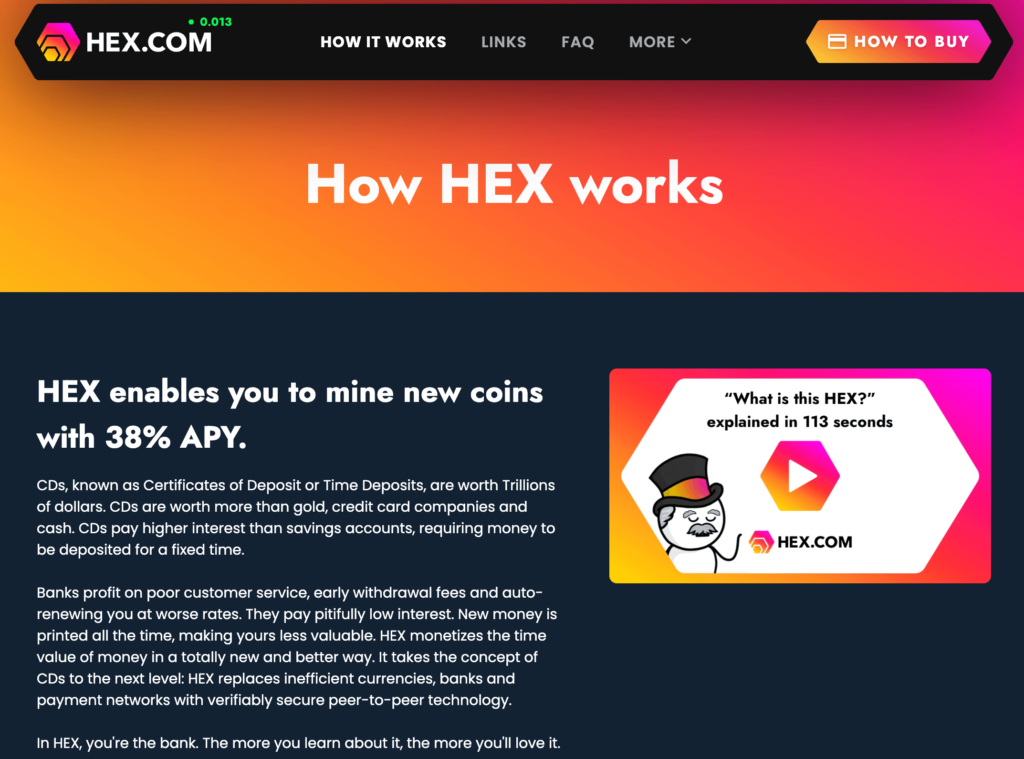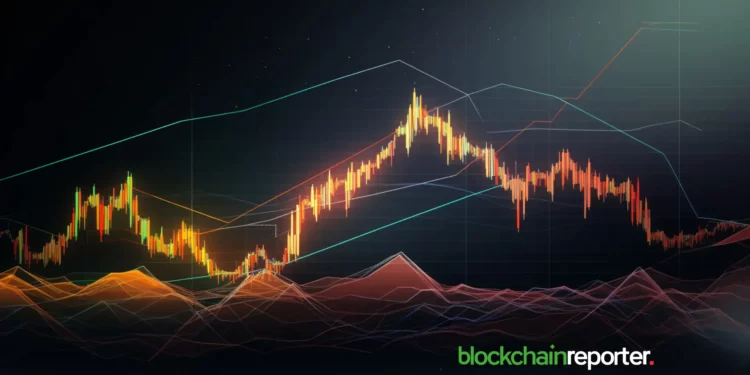Some people keep saying HEX is a scam, but they’re missing the point. HEX is a cryptocurrency that works more like a regular bank’s savings plan, known as a Certificate of Deposit (CD). With CDs, you put away your money for a set time, and in return, you get interest. It’s a tried-and-true way to save money, just a bit dull for some. HEX does something similar but in the crypto space. It’s Bitcoin’s younger cousin, built using a similar base, but it is based on Ethereum’s blockchain network.
The interesting part is that it doesn’t rely on the heavy computer calculations that Bitcoin does, known as “Proof of Work.” Instead, HEX uses a “sit and wait” strategy, where the longer you keep your coins without touching them, the more you earn. They call it “Proof of Wait.” A bunch of people who got into HEX early didn’t just double their money; they made millions. Some even crossed over into the crazy $100 million territory. And one can check all this online because blockchain records are public.
Despite all the success, the community still trash-talk HEX. But the reality is HEX has been going strong for 2.5 years now. In this article, we’ll discuss HEX coin price with in-depth technical analysis, HEX coin price prediction, and future market trajectory to guide you with a profitable investment plan amid market recovery.
HEX: A Quick Introduction
Richard Schueler, known as Richard Heart, created HEX after gaining fame from blogging about spamming. He makes up to $17,500 annually from YouTube ads, as per SocialBlade. However, HEX, which doesn’t earn but promises high returns, seems to operate on a “Ponzinomics” model, where profits are likely just funds from new investors. Despite the risks, some people are attracted to the bold marketing and potential quick profits showcased by HEX enthusiasts.
HEX, according to its main site, aims to be the first ‘time deposit’ for digital money, similar to savings plans offered by banks. These bank programs usually offer slightly better earnings than regular savings accounts because customers agree to leave their money untouched for a certain time. With HEX, it’s similar. People earn by committing not to touch their HEX cryptocurrency for a while, anywhere from a day to multiple years.
Unique to HEX is its ‘proof-of-wait’ system. It doesn’t rely on the usual cryptocurrency ‘miners’ to make new money. Instead, by just holding onto HEX for the agreed time, investors themselves generate new HEX. When the wait is over, the system automatically makes new HEX to pay the investor, turning them into the kind of ‘miners’ for this system.
HEX operates on the Ethereum system, functioning as a second-layer application. This means it’s not part of Ethereum’s core but adds on to it, helping Ethereum handle more transactions. It uses ‘smart contracts‘ (digital contracts that execute tasks automatically) to control how new HEX is made and given to investors.
Right now, HEX promises an average yearly return of 40%, though it can change based on how long investors keep their HEX untouched. They receive their rewards in a new HEX created specifically for their payout.

The way HEX is set up, fewer HEX would need to be created (and therefore given to investors) as the value of HEX goes up. But, if values plummet suddenly, the system would need to make a lot more HEX to give the same payout, causing a kind of inflation for the cryptocurrency.
In short, HEX assures that people will always get paid in HEX currency. Since its value has skyrocketed before, more and more investors are jumping in, hoping they’ll gain from not only the high annual returns but also from any further increases in HEX’s value.
It’s important to note HEX is a type of digital asset called a ‘token,’ seeing as it’s built on Ethereum’s blockchain system. Sometimes, people might incorrectly refer to it in terms like “HEX coin,” but that’s not technically accurate.
HEX: Fundamental Analysis And Tokenomics
To grasp HEX’s operations, it’s crucial to understand ‘staking‘ and the role of ‘share price’ in determining payouts.
Stakers of HEX tokens see an average return of 38%, a striking figure compared to the maximum 2% annual interest from most US banks. ‘Staking’ in this context means using a digital contract to commit your HEX for a certain period, like keeping 10,000 HEX untouched for five days. These tokens can’t be used during this time, but once the period ends, you get back your 10,000 HEX plus interest. This process is similar to bank Certificates of Deposit (CDs).
Your actual gain comes from a pool based on your proportion of total shares, not the number of HEX tokens. For example, if you stake 10 HEX and get a 40% bonus, you receive 14 shares. Your payout depends on your share count compared to the total, making bonuses crucial as they increase your returns, sometimes more effectively than simply starting with extra HEX.
The system favors longer or larger stakes, ensuring they pay more over time. This works through a ‘share price,’ set after each stake ends, reflecting its success. Future stakers must use this new price to turn HEX into shares.
HEX’s basic unit is the ‘Heart’ (like ‘Satoshis’ to Bitcoin), with 100,000,000 Hearts equaling one HEX. Initially, the share price is 1 share per Heart, changing based on stakers’ gains. So, if a staker ends with a 20% profit, the new share price becomes 1.2 Hearts, affecting future transactions.
HEX draws from traditional bank CDs, valued in the trillions, but transitions into cryptocurrency, offering higher average returns without the bank charges. Users can stake HEX tokens for up to 5555 days, with the reward growing depending on how long the stake is.
Evaluating the Risks Of HEX
When thinking about the future of the HEX cryptocurrency, it’s important to keep in mind several risks:
- Controversy Over Potential Scam: HEX has faced criticism and accusations of being a potential scam or Ponzi scheme. They’ve addressed these claims on their website in a dedicated section. However, the ongoing debate is a red flag, and it’s wise to do in-depth research before relying on any HEX price predictions.
- Limited Availability: Though you can find HEX on about 20 cryptocurrency exchanges, it hasn’t made its way onto the world’s largest platforms. This limited presence is noteworthy because smaller exchanges often face higher risks of hacks.
- Dependence on Reputation: The value of HEX heavily relies on its perceived trustworthiness. If, for any reason, the project’s credibility takes a hit, the price could fall sharply. This vulnerability stems from the way the system operates; if trust decreases, a massive amount of tokens might need to be produced to compensate current investors, potentially flooding the market. A sudden spike in supply, with demand not keeping pace, could significantly drive down prices.
These factors underline the need for careful consideration and independent research before investing in or handling HEX cryptocurrency.
HEX Coin: Price History
HEX, a cryptocurrency, officially started trading on December 2, 2019, at an initial price of $0.0002 and experienced its first major price jump in May 2020. This increase happened alongside a rise in the total value of money participants locked into the system, jumping from less than $50 million in April to $340 million by May 15, as noted by DeFi Llama.
The cryptocurrency saw another increase in November 2020, hitting $0.0014, following the release of a supportive staking app. Its most remarkable surge came in May 2021, when the price broke the $0.01 barrier, peaking at $0.06965 on May 14 due to the platform’s rising popularity and a significant boost in staked value, touching nearly $4 billion.
Another noteworthy peak happened on July 15, 2021, with HEX closing at $0.1715. Around this period, HEX’s creator, Richard Heart, unveiled an alternative blockchain platform, PulseChain, to combat high transaction fees on Ethereum. He also announced a new cryptocurrency, PulseX, available for pre-ordering.
The price of HEX soared again in September, reaching highs of around $0.49. This led to debates about its actual market position, with claims of it being the third-largest cryptocurrency. However, these assertions were hard to confirm, and if it did hit third place, it was probably brief, as it ranked 20th later in September.
After some fluctuations, including claims of reaching an all-time high of $0.5561 in November, the price dropped to around $0.2325 by October’s end. Despite a small rebound in December 2021, linked to a new version of the PulseChain testnet, HEX underwent a significant decline, hitting $0.019 in December 2022.
In early 2023, HEX experienced a brief resurgence, peaking at $0.10 in March, but soon after, it entered a bearish phase, from which it hasn’t recovered.
HEX Coin Price: Technical Analysis
Recently, the HEX coin price experienced intense bullish sentiment, which has triggered buyers near the immediate resistance levels. The price has been on a steady upward trajectory over the last few weeks due to the market’s ‘Uptober’ trend revival. After surging above the $0.004-mark, HEX’s price sparked an intense buying momentum and surged exponentially. As the market was previously heavily influenced by declining investor interest and fake ETF news, HEX’s price consolidated within a bearish region. The price has been facing intense buying pressure recently, and it managed to break above multiple resistance levels following Bitcoin’s surge above $35K. A thorough technical analysis of HEX token price reveals mixed indicators, which may soon send the price either to new lows or highs.
According to Coinmarketcap, the HEX price is currently trading at $0.009, reflecting a decrease of 13.6% in the last 24 hours. Our technical evaluation of HEX price indicates that the current bullish momentum may soon fade as bears are attempting to reverse the trend from the upcoming resistance at $0.012; however, bulls are trying to prevent the price from dropping below the support level of $0.005. Examining the daily price chart, HEX coin price has found support near the $0.0063 level, from which the price gained bullish momentum and broke above multiple Fib channels. As HEX price continues to trade below the EMA200, sellers are gaining confidence to open further short positions and send the price to test its upcoming support. The Balance of Power (BoP) indicator is currently trading in a negative region zone at 0.93 as sellers are increasing their domination on the price chart.
To thoroughly analyze the price of a HEX coin, it is crucial to take a look at the RSI-14 indicator. The RSI indicator recently experienced a decline as the HEX price failed to hold buyers’ demand near $0.012. The trend line is currently hovering below the midline as it trades at level 45, hinting that further downward correction is on the horizon. It is anticipated that the HEX price will soon attempt to break above its 23.6% Fibonacci level to achieve its short-term bullish goals of around $0.01. If bears fail to plunge below the current 0.038 Fibonacci region, an upward trend might be on the horizon.
As the SMA-14 continues its downward swing by trading at 57, it trades slightly above the RSI line, potentially holding promises about the coin’s upward movement on the price chart. If HEX price makes a bullish reversal, it can pave the way to resistance at $0.012. A breakout above will drive the coin’s price toward the upper limit of the Bollinger band at $0.018.
Conversely, if HEX fails to hold above the critical support region of $0.005-$0.006, a sudden collapse may occur, resulting in further price declines and causing the coin’s price to trade near the Bollinger Band’s lower limit of $0.004. If the price fails to continue a trade above, it may trigger a more significant bearish downtrend to $0.0026.
HEX Coin Price Prediction By Blockchain Reporter
HEX Price Prediction 2023
Projected technical analyses suggest that in 2023, HEX’s value could hover around a consistent rate of $0.007, representing both the potential high and average price for the year.
HEX Price Prediction 2024
Analytical forecasts for 2024 indicate a potential rise in HEX’s value, with a floor price of $0.010 and the possibility of peaking at around $0.011. The median price for trading activities is expected to stabilize at $0.010.
HEX Price Forecast for 2025
Predictive analytics show that 2025 could see HEX attaining a baseline value of $0.015, with an upward threshold of about $0.017, maintaining the average price at $0.015 for the duration of the year.
HEX (HEX) Price Prediction 2026
Forecasts for 2026 suggest a steady climb for HEX, with its value bottoming out at $0.022 and potential highs of $0.025. The aggregate trading value is anticipated to hold at an average of $0.022.
HEX Price Prediction 2027
In 2027, HEX’s price trajectory is slated to continue its ascent, establishing a floor at $0.031 and potentially climbing to a ceiling of $0.038, with a mean trading value around $0.032.
HEX Price Prediction 2028
Analytical projections for 2028 indicate that HEX could bottom out at $0.046, with room to grow to as much as $0.054, while the mean value is likely to hover around $0.047.
HEX (HEX) Price Prediction 2029
Come 2029, HEX’s value is forecasted to reach a minimum of $0.067, with the potential to escalate to around $0.079. The average trading price over this period is projected to be $0.069.
HEX Price Forecast 2030
Deep technical analysis predicts a 2030 landscape where HEX’s value could bottom out at $0.10, with the potential for reaching highs of $0.12. The consistent trading average is projected at $0.10.
HEX (HEX) Price Prediction 2031
In 2031, projections indicate that HEX’s minimum value could hit $0.15, with a ceiling of up to $0.18, sustaining an average trading price of $0.15 throughout the year.
HEX Price Prediction 2032
By 2032, HEX is expected to sustain a growth trajectory, with its value potentially bottoming out at $0.22 and peaking at around $0.25. The average trading figure is forecasted to maintain at $0.22.
HEX Coin Price Forecast: Experts’ Opinions
According to the current HEX price prediction on Coincodex, the price of HEX is anticipated to decrease by -7.14% and reach $ 0.008376 by November 1, 2023. The technical indicators on Coincodex suggest that the prevailing sentiment is Bearish, with the Fear & Greed Index indicating a score of 70, categorized as ‘Greed.’ Over the past 30 days, HEX experienced 16 out of 30 green days (53%) and price volatility of 51.71%. Coincodex’s forecast advises that it is currently an unfavorable time to purchase HEX.
Drawing on historical price trends of HEX and BTC halving cycles, Coincodex estimates that the yearly low for HEX’s price in 2024 could be around $ 0.007867. However, there’s potential for growth in the following year, with HEX’s price predicted to climb as high as $ 0.020539.
Digital Coin Price gives a bullish prediction on Hex’s future market performance as the team believes that HEX price will surpass $0.0195 in 2024. By the end of 2024, Hex might attain a maximum price of $0.0212 and a minimum price of $0.019.
Is HEX Coin A Good Investment? When Should You Buy?
Hex coin has lost most of its gains over the years, and the community continues to hate this project due to its utility and fishy offerings. HEX has faced substantial scrutiny and allegations of fraudulent activity.
The digital currency has notably been disparaged for its similarities to a Ponzi scheme. Heart conceded that the initiative employs strategies commonly associated with deceptive practices. As a result, it is wise not to invest in this project.
Conclusion: SEC’s Charges On HEX
HEX presents itself as a digital alternative to traditional certificates of deposit, built solely for the purpose of value storage with the anticipation of investment returns. In July 2023, the SEC filed charges against Richard Heart, the architect behind the cryptocurrency, accusing him of orchestrating an unregistered securities offering.
The U.S. Securities and Exchange Commission (SEC) accused Richard Heart of unlawfully amassing over $1 billion through three unregistered digital currency offerings and misappropriating $12.1 million from investors for extravagant purchases, including the world’s most substantial black diamond.
Hence, it is advised to do your own research and conduct experts’ opinions before investing in the HEX project.
FAQ
Is Hex a good investment?
Hex has faced significant scrutiny and allegations of fraudulent activity. It has lost most of its gains over the years, and some have noted its similarities to a Ponzi scheme. The SEC has also filed charges against its creator, Richard Heart. Therefore, it’s recommended to do thorough research and exercise caution before investing.
How does a hex coin work?
Hex is a cryptocurrency that operates similarly to a bank’s Certificate of Deposit (CD). Instead of relying on the “Proof of Work” system like Bitcoin, Hex uses a “Proof of Wait” strategy. The longer you hold onto your Hex without spending or trading it, the more you earn. Hex operates on the Ethereum blockchain and uses smart contracts to control the creation and distribution of new Hex to investors.
What does hex actually do?
Hex aims to be the first ‘time deposit’ for digital money. It functions similarly to bank savings plans, offering better earnings if users agree to leave their money (in this case, Hex cryptocurrency) untouched for a certain period. Instead of relying on cryptocurrency miners, Hex lets its holders generate new Hex by holding onto their existing Hex for a specified duration.
Who created Hex?
Hex was created by Richard Schueler, also known as Richard Heart. He had previously gained fame from blogging about spamming and earns from YouTube ads. However, it’s essential to note that Heart faces charges from the SEC regarding Hex.
How does the ‘proof-of-wait’ system work in Hex?
Unique to Hex, the ‘proof-of-wait’ system means that instead of relying on the usual cryptocurrency miners to create new money, by holding onto Hex for the agreed time, investors themselves generate new Hex. Once the waiting period is over, the system automatically creates new Hex as a reward for the investor.
What are the risks associated with Hex?
Hex has faced controversies, including potential scam allegations and its absence from significant cryptocurrency platforms. Its value heavily depends on its perceived trustworthiness. Any damage to its reputation could significantly impact its price.
How is Hex different from other cryptocurrencies?
Hex is a type of digital asset called a ‘token’ since it operates on Ethereum’s blockchain system. It functions more like a regular bank’s savings plan, with a focus on a “sit and wait” strategy, rather than the mining process that many other cryptocurrencies utilize.
What are the potential future prices of Hex?
Future projections for Hex’s price range from $0.007 in 2023 to potentially reaching values of $0.25 by 2032. However, these are predictions based on current data and could change based on various factors.























